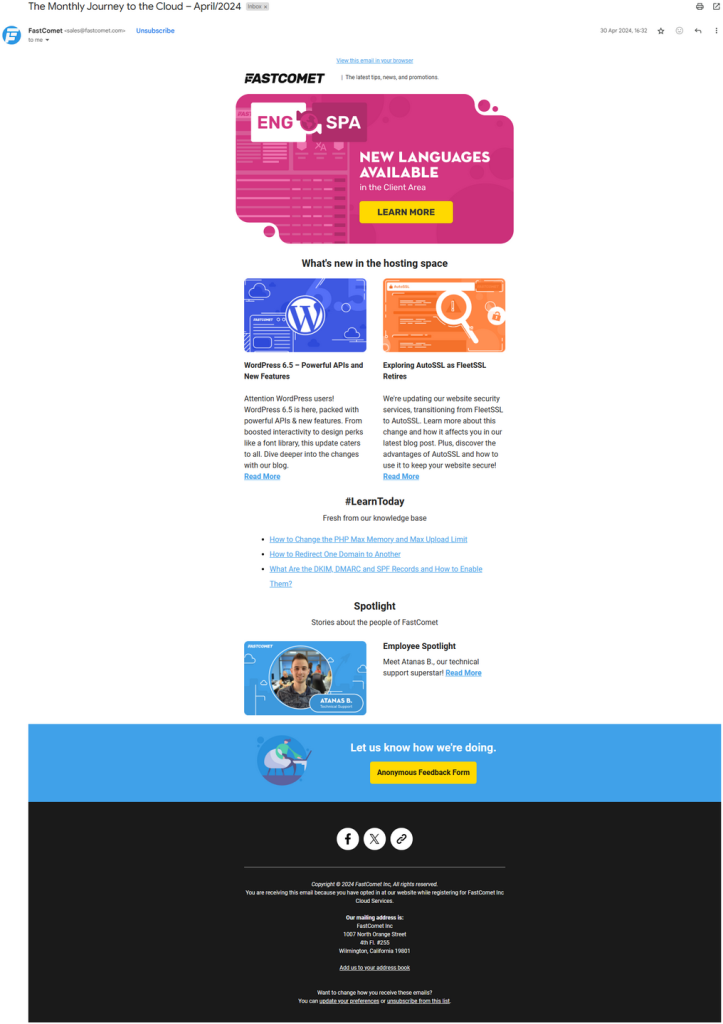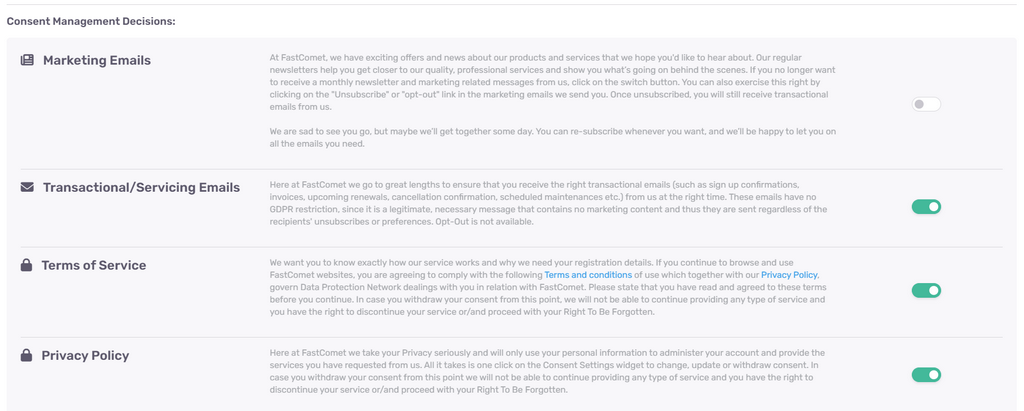
The Benefits of Building an Email List
Everyone knows about emails! Emails are everywhere, and we would be surprised if any of our readers don’t have an email address. We know all our customers do because we require it on signup. If you are here just for the blog posts, though, and not a customer of ours, then hello to you specifically. Nonetheless, with emails being such a big part of everyday life nowadays, it should be no surprise that companies use them almost exclusively to communicate with their customers. That goes beyond one-on-one conversations. We are talking en masse, emailing everyone who subscribed to the mailing list. Such an email list is a giant benefit for an organization that wants to keep its customers informed. It allows for instant and direct communication that lands in individual inboxes, all while out of the public eye.
If there are things you need to keep your visitors informed about, we strongly recommend creating an email list if you haven’t already. It is an excellent way to connect with your subscribers, keep them up-to-date with all developments regarding your website or business, and even build trust and rapport with them. There is a reason why emails are still going strong: they are an efficient way to inform and be informed. Of course, there is always the stigma of “spam,” but in this blog post, we will tell you all about how to create and curate an email list of your own without spamming your subscribers!
What is an Email List?
It is actually very easy to answer that question. An email list is a list of email addresses of people who have subscribed to receive emails from you. The topic of such emails is typically marketing or promotions, announcements, newsletters, or customer engagement.
The list itself is precisely that: an index of email addresses to which a company can send emails in bulk. It allows a company to easily communicate with its customer base, which is the biggest draw for such a list. It is an easy and convenient way to keep your subscribers informed of everything happening with your company, business, website, etc. However, there are several other upsides, so let’s look at them as well.
Why is an Email List Important?
Many new businesses or website owners generally don’t realize how important an email list is. Moreover, most people associate email lists with spam, sometimes making emails appear even less appealing. That is not unfounded, considering more than 350 billion, yes billion, emails are sent out each day. No way all of those are not spam, right? However, it is not all doom and gloom because a well-curated email list can greatly benefit a business while eliminating the concern of being considered “spam.” With its help, your emails can stand out from the clutter. In reality, such a method of communication is very important not just for your own marketing strategy but for all your subscribers as well. If a user is subscribed, they want to be informed about everything going on with your business or website. Ideally.
It is also important to stress that an email list is for more than just marketing and advertising. The content of an email list can be anything: news, updates, announcements, communication, polls, product availability, etc. Anything you can think of you can put in an email blast to your list. Here is a direct example: our newsletter from last month.

As you can see, it focuses on informing and educating rather than marketing. That is why we said the content you send to your email list could be anything you want, hoping it will alleviate the stigma against mass emails. However, let’s look at some specific benefits of having a strong, curated email list.
Direct, Individual, With a Specific Purpose
An email list is a way of communicating with all your customers on an individual level. Your message does not get splayed on a public timeline for everyone to see; instead, it lands in the individual inboxes of your subscribers. Additionally, if someone has subscribed to your email list, that typically means they are interested in what you have to say. That in itself is a big benefit because, ultimately, you will be sending emails only to those who want to receive them. A smaller but dedicated subscriber base is much better than a large one that mostly ignores what you have to say.
A cultivated email list like that is something your business will use for years to come. It will grow and shrink as customers come and go, but in the long run, it will pay for itself since it will consist of an audience interested in what your business or website offers. That, in turn, means they will open those emails far more often than the average person, meaning they will see what you send more often.
Additionally, such communication is private since the email lands in an individual user’s inbox and not on a public timeline. With such an individual approach, you can allow yourself a more personal connection to your customers, especially if you allow them to reply to your emails. For example, you can offer personalized content depending on the specific user’s purchase history or answer questions for them directly. A one-on-one communication channel like that is a significant asset.
Inexpensive, and You Own It
The creation of the email list itself is almost free. You can have a subscription form baked into the design of your website. It can be an option in a user’s account setting or during signup.
No matter where, collecting emails in itself should be relatively cheap. There will be costs of sending emails to that list, but even then, those costs should not be anything major in the long run. The list itself should pay for them anyway. That is called Return on Investment (ROI); for 2024, it is predicted to be $42 for every $1 invested. That sounds like a staggering amount, but when you think about it, it does not sound so outlandish. We will go more into this later, but there are inexpensive email marketing services on the market (which is what you need to be able to send all of your emails). With your email marketing service being cheap or free, you can see how all other profits from your email list are yours for the taking.
Finally, around 5% of people actually follow the hyperlinks inside marketing emails. 5% doesn’t sound like much, but it can compound into some very decent numbers when you have hundreds or thousands of people on your list. If only a few people spend money on your website, the list has already likely paid for itself; besides the added benefit, you are not relying on a third-party service to manage your email list. It is not subject to change to algorithms or platform policies either. You will always be able to reach your customers.
A Lot of People Still Use Email
Despite email being old technology, there are billions of email accounts online. How many? In 2024, just under 4.5 billion email accounts are active on the internet. Yes, billion. That number is not going down either and is instead projected to climb to more than 4.7 billion by 2026. Furthermore, 99% of people with an email account check it daily. With statistics like these, it is more than clear that email is here to stay and is one of the best ways to reach your subscribers.
Social Media vs Email List
With social media being as pervasive as it is, you might think email blasts (sending an email to a large audience) might be pointless. Social media lets you inform all your followers at once as well, without having to have a list of their email addresses. They are the ones following you, after all.
That might be true, but several aspects of social media make an email list more appealing.
- Algorithm – The big “A” word. Everything revolves around it in social media, and no post is an exception from it. Ultimately, the algorithm dictates whether your followers see your latest post. That is not a concern with an email because it arrives directly in a user’s inbox. Whether they click on it is up in the air, just how it is with a social media post, though;
- Overcrowding – Not by users, but by content. There is so much happening on social media nowadays that your post can get butted out of the way by others. Even if someone is following just you, their feed will still be full of other content. While users can still receive many emails every day, it is still easier to sift through them than through social media posts. That is further proven by the average open rate for emails of around 15-25% as opposed to the average click-through rate on social media of 2.5%. Checking an email account is simply more time-efficient than scrolling through social media;
- Personalization – A social media post is more of a catch-all solution. Conversely, an email can be tailored to fit a subscriber’s needs or interests. According to a subscriber’s interaction history, preferences, subscriptions, etc., an email can be altered to show what that particular subscriber is interested in. The community typically receives such personal touches very well. It also helps build trust, and demonstrates a commitment to improving your subscribers’ experience.
We don’t want you to think we are anti-social media, though! Social media has its place when it comes to marketing and mass communication. If you have the opportunity, we strongly recommend that you build a social media presence and nurture a community there as well. Social media is one of the best ways to drive quality traffic to your website. We have a blog post precisely on that topic that you can check out here.
How to Build an Email List
Finally, let’s learn how to build and curate an email list. It is not enough to simply collect a bunch of email addresses and then send away. No, that is not a good practice. From the moment you start collecting those emails you must be thinking about the customer experience, as well as the quality, relevance and reputation of your emails.
Where to Start?
We touched on this earlier, but the best place to start is with your website’s design—specifically, the registration page. When a visitor registers with your website, give them the option to subscribe to your email list. That is what the option looks like on our page.

As you can see, it is simple and unobtrusive but calls to action. However, it is not the only place to put such a field. Some of the best places for an opt-in form are the home page, a notification bar, a popup box, or the sidebar. Of course, don’t forget the other side of the coin and add the option for your customers to opt out of all or some of your emails. It will not help your email list, but users consider it good manners nowadays, and they severely look down upon the lack of such an option. Even more so, the inclusion of an “unsubscribe” button is the law in the United States.

Great! Now you have a means to start building an email list! On that note, we strongly recommend never buying an email list. Yes, you can actually purchase a pre-made email list to supposedly kickstart your emailing process. That is not a good way to do business, and there are many reasons why: it can be full of bad or dead email addresses; the people on the list are not aware of your website; and it also violates international law, to name a few.
An Email Marketing Service
The next step is to get a service that allows you to send all your emails simultaneously without issues. You could add all those email addresses to your newly written email in Gmail, but we don’t recommend it. Most email service providers have a cap on how many recipients you can email. For Gmail, it has 500 recipients –or 2000 if you share the same organization- but that likely won’t apply in your use case. You could do that, of course, but at the same time, everyone you sent the email to will also see everyone else’s address. Not very professional or safe.
The same goes for sending bulk email via any non-specialised service, such as the email service our hosting plans provide. We do not recommend you do that because the emails we provide are not meant for utilizing such email lists. Sending high volumes of messages can negatively impact your ability to continue sending emails.
That is why an email marketing service is the best course of action here. But what is an email marketing service? Simply put, it is an email service that allows you to send campaigns (lots of emails), build email templates, obtain metrics and data on those campaigns, automate them, and also segment your mailing list. There are many such services online, but we have selected a few to highlight.
Brevo

Brevo is an excellent email marketing solution if you are just starting out or are looking for something inexpensive. It is feature-rich despite its affordable pricing plans and should suit anyone from a complete beginner to a middle-sized operation. Here are its most prominent features.
- Simple to use drag-and-drop builder;
- Personalization features for targeted campaigns;
- Capability for advanced email list segmentation;
- A/B testing.
Brevo will not break the bank, allowing you to email thousands of users.
Hubspot

Hubspot is the more expensive alternative to Brevo, but with a higher price comes more sophisticated features. Aside from the typical email marketing features (drag-and-drop builder, for example), Hubspot also sports some advanced solutions, such as:
- In-depth personalization sequences;
- Complex automatization features;
- Sophisticated A/B testing;
- High-end segmentation;
- Customer lifecycle synchronization.
While their pricing may be steeper than Brevo’s, their advantages would likely be worth it to a bigger company looking to expand or solidify its email marketing campaigns.
ActiveCampaign

Last but definitely not least is ActiveCampaign: an email marketing solution that is great for almost any size business or website and sports some amazing features that set it apart from the other two.
- Simple personalized email campaign creation;
- Smart and responsive automation features;
- Unified interface to monitor customer interactions and lifetime values;
- Advanced machine learning techniques for insights into customer behavior.
However, these advanced features make ActiveCampaign’s pricing a bit steeper than typical. It does offer a free trial, so we recommend trying it out!
Curate and Segment
Now that you’ve started collecting email addresses and have chosen an email marketing service, it’s time to start managing it. It’s not enough to simply have a list of emails: you have to manage it. You have to curate and segment it to ensure it is functioning optimally.
That means removing any email addresses that are no longer in use, for example. Such addresses will create bounces (undelivered emails), harming your metrics and email reputation. You don’t want your metrics to show undelivered or unopened emails because your list has invalid email addresses, which skews everything and misleads you when reading that information. You can use any of the many tools that exist online to check the validity of the emails on your list.
Additionally, you might also want to keep an eye on which email addresses have stopped opening your emails. Those subscribers are no longer interested in your emails, and it may be better to remove them. That way, your emails will have a lesser chance of being marked as spam, which is also bad for your sender’s reputation. While on the topic, ensure that your emails are relevant to what your subscribers expect. The content you send out via those emails should be about your website or business.
Next, ensure that you offer incentives for website visitors to become subscribers. Your email list should grow almost constantly; such incentives can be an excellent way to do that. You can offer rewards that are available only to subscribers, for example.
Finally, segment your email list. The email marketing services we mentioned above can help you with that. A segmented email list allows for personalization of the emails based on customer interests, past purchases, demographics, etc. That way, you’ll keep your subscribers engaged with content they are interested in.
Get That List Going!
Having an email list to keep your customers informed and communicate with them is a giant benefit for any new or established website or business. If you want to interact with your visitors, keep them informed regarding everything happening with your website, and offer them incentives and rewards, an email list will allow you to do all of that. It is an inexpensive solution that should help your website or business grow, flourish, and build a community of interested customers around itself.

The latest tips and news from the industry straight to your inbox!
Join 30,000+ subscribers for exclusive access to our monthly newsletter with insider cloud, hosting and WordPress tips!


No Comments